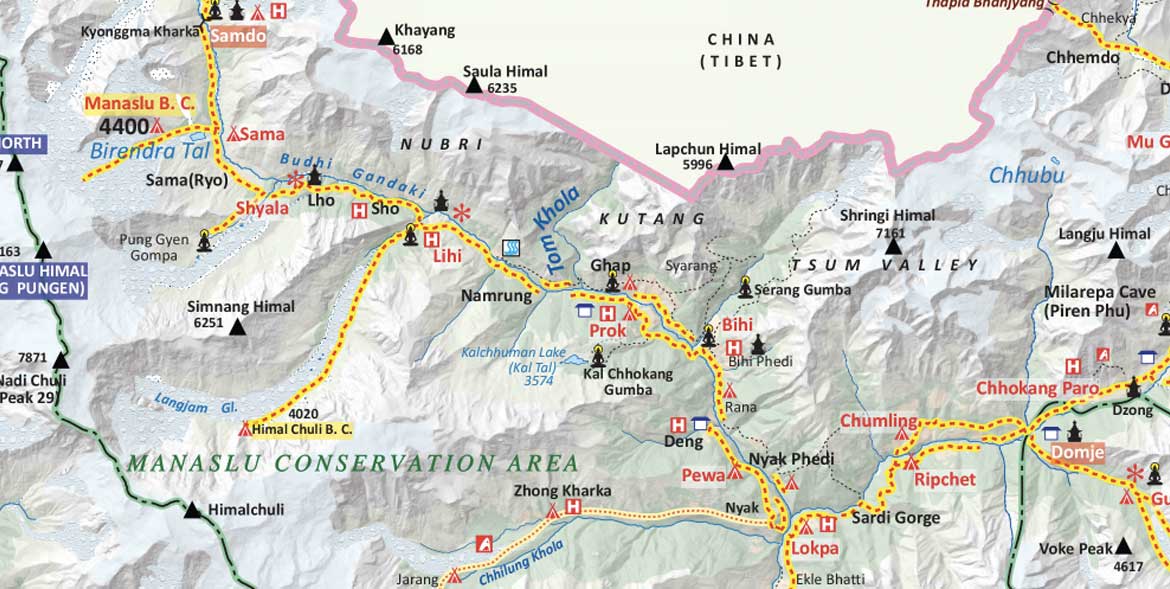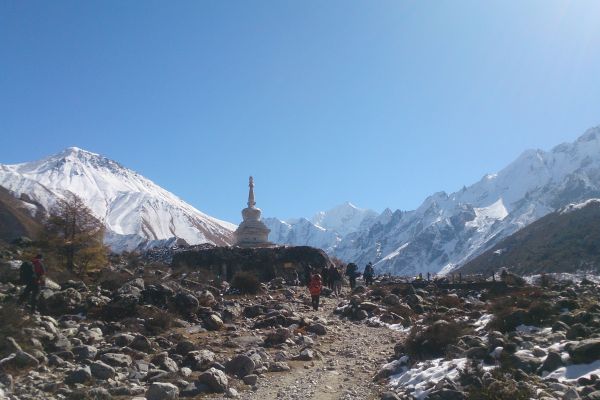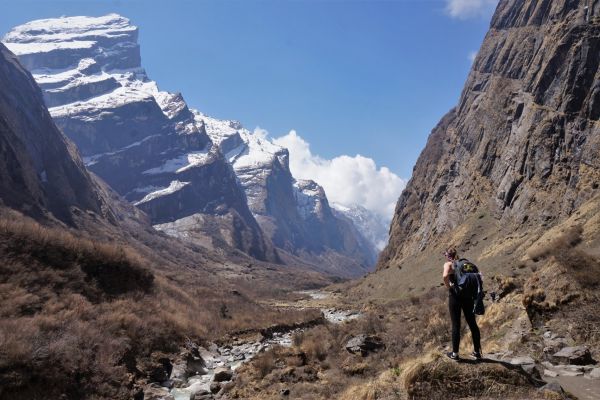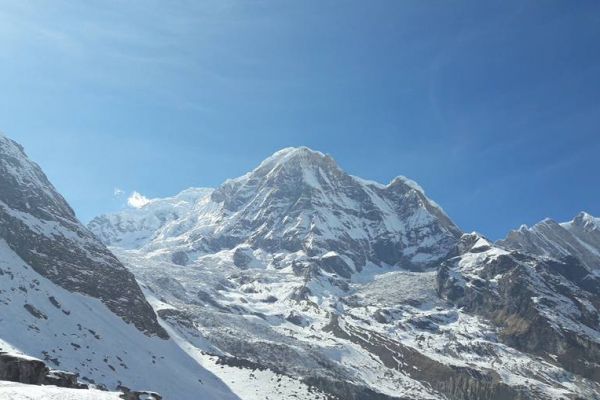- Trip Code : NTE-MTT29
- Trip Duration : 18 Days
- Trip Level : Strenuous
- Trip Max Altitude : 4100
- Trip Start Location : Kathmandu
- Trip End Location : Kathmandu
- Trip Route : Kathmandu-Arughat-Jagat-Chhokangparo
- Trip Best Season : March-April & August-November/December
Trip Highlights
- Tatopani
- Old Gumba (Buddhists Monastery)
- Beautiful surroundings of Ganesh Himal and Budhi Gandaki River
- Conserves steps of the great Buddhist Yogi Chuchin Milarepa
- Rinchen Gumba and Dephyudonma Gumba
- Scenic drive all the way to arughat to and from
Trip Information
Situated on the east of Manaslu, near the Tibetan border, Tsum valley trek is a holy Himalayan trek, where you can experience the adventure of the trek in the remote and isolated area of Tsum Valley. It is one of the most famous destinations which takes you to some of the most remote Himalayan valleys in Nepal. The hidden Tsum Valley offers you to explore untouched Valley, century-old Tibetan Buddhist monasteries with ancient villages. Besides the physical beauty of Tsum Valley, you will also get an opportunity to encounter with the Tibetan people known as “Tsumbas” and their unique culture and traditions as well as experience the warm friendliness nature of local people. The Tsum Valley is rich in Tibetan unique cultures and traditions. In this area, usually, you will find most hospitable the people who will always welcome you in their traditional way. You will be welcome as you are a guest and provide you chances to test their cultural food (Dal Bhat, Chapatis, noodle soup) in their home is really incredible. The Tsum Valley is filled with natural beauty, ancient Buddhist Monasteries, significant religious Monuments, Nunneries, Chortens and Prayer Walls and the longest Mani walls at Dzong and Phurpe and magnificent views of the Himalayas such as; Himalchuli. Ganesh Himal Range, Sringi Himal, Buddha Himal, and many more.
During your trek to the most disconnected Himalayan Tsum Valley, the stunning Himalayas will accompany with you. The trek leads you through the beautiful Budhi Gandaki River surrounded with the Ganesh Himal. Throughout the trek, you will witness wild and uncharted places, home to Gurung ethnic groups. As you reach the Tsum Valley, you will feel totally different than the region was a part of Tibet. Furthermore, you will also get chances to explore authentic Gumbas (Buddhists Monasteries) of the region which includes: Ranchen Gumba and Dephyudonma Gumba. Each day you need to walk between 5-8 hours, with the highest point of the trek being 4,000m above the largest monasteries in the valley, Mu Gumba.
Short Itinerary
- Day 1 - Arriving in Kathmandu.
- Day 2 - Kathmandu Sightseeing and trek preparation.
- Day 3 - Drive Kathmandu- Arughat.
- Day 4 - Trek from Arughat to Soti Khola to Maccha Khola.
- Day 5 - Trek to Jagat (1345m) 6-7 hrs walk.
- Day 6 - Trek to Lakpa (2240m), 6 hrs walk.
- Day 7 - Trek Chumling (2386m) (Lower Tsum); 4-5 hrs walk.
- Day 8 - Trek to Chhokangparo (3031m), 4-5 hrs walk.
- Day 9 - Trek to the Nile (3347m) via Milarepa Cave, 5-6 hrs walk.
- Day 10 - Excursion Mu Gompa (3700 m) and Dhephyudonma Gompa (4060m) 5-6 hrs. walk.
- Day 11 - Trek to Chhekamparo (3031m), 4-5 hrs walk.
- Day 12 - Trek to Gumpa Lungdang (3200m), 6 hrs walk.
- Day 13 - Trek to Lokpa, 6-7 hrs. walk.
- Day 14 - Trek to Jagat, 6-7 hrs walk.
- Day 15 - Trek to Lapubesi 6-7 hrs walk.
- Day 16 - Trek to Arughat, approximately 6-7 hrs walk.
- Day 17 - Drive to Kathmandu from Arughat, 7-8 hrs drive.
- Day 18 - Final Departure.
- Day 1 Arriving in Kathmandu.
- Day 2 Kathmandu Sightseeing and trek preparation.
- Day 3 Drive Kathmandu- Arughat.
- Day 4 Trek from Arughat to Soti Khola to Maccha Khola.
- Day 5 Trek to Jagat (1345m) 6-7 hrs walk.
- Day 6 Trek to Lakpa (2240m), 6 hrs walk.
- Day 7 Trek Chumling (2386m) (Lower Tsum); 4-5 hrs walk.
- Day 8 Trek to Chhokangparo (3031m), 4-5 hrs walk.
- Day 9 Trek to the Nile (3347m) via Milarepa Cave, 5-6 hrs walk.
- Day 10 Excursion Mu Gompa (3700 m) and Dhephyudonma Gompa (4060m) 5-6 hrs. walk.
- Day 11 Trek to Chhekamparo (3031m), 4-5 hrs walk.
- Day 12 Trek to Gumpa Lungdang (3200m), 6 hrs walk.
- Day 13 Trek to Lokpa, 6-7 hrs. walk.
- Day 14 Trek to Jagat, 6-7 hrs walk.
- Day 15 Trek to Lapubesi 6-7 hrs walk.
- Day 16 Trek to Arughat, approximately 6-7 hrs walk.
- Day 17 Drive to Kathmandu from Arughat, 7-8 hrs drive.
- Day 18 Final Departure.
Price Includes
- Arrival and departure airport transfer
- Standard hotel accommodation in Kathmandu on Twin share with breakfast
- Welcome dinner with cultural program
- Half day guided cultural tour in Kathmandu with heritage entrance permit
- Teahouse / lodge accommodation while on trek on twin share
- Full board meals while on Trekking
- Properly boiled drinking water, tea and coffee
- Manaslu region conservation entry trek permit and other trek documentation.
- Private transportation from Kathmandu to Arughat-Kathmandu
- Free use of trekking gears like sleeping bag, down jacket, liner, trekking poles etc
- Complementary trek duffle bag and T- shirt to every trekkers on Tiji festival trip.
- Medical trained experienced trekking guide with first aid kit
- Trek Sherpa and porters with all their gear, wages and insurance etc.
- A Kathmandu city map and Manaslu region trekking map
- Comprehensive pre departure and trip dossiers for the mustang trek
Price Does not Include
- Nepal entry visa and your personal travel insurance of any kind
- International airfare
- Drinks and main meals while on city like Kathmandu and Pokhara
- Tips and items of personal nature expenses like postage, laundry etc
Trekking equipment and clothing needed for this trek
Clothing for Kathmandu: - Informal clothing is all that is required. Remember to dress in a modest fashion. Light clothing is usually all that will be required for most of the year. During the winter months, December to February, it will be chilly in the early mornings and evenings. A warm fleece or similar jacket will be required. Do bring along a swimming costume as our hotel in Kathmandu has a swimming pool.
General Gears you need During Trekking: -
- 4 seasons Sleeping bag (we provide one if you need but is to be returned after the trek)
- Duffel bag or Rucksack (70-80 liters) (we can provide one)
- Down Jacket (we provide one if you need one but is to be returned after the trek)
- Daypack (25-30 liters)
- Socks: 4 pairs of liner socks, synthetic or capilene, 3 pairs heavy weight socks (woolen) to be worn over liner socks
- Trekking Boots: 1 pair light trekking shoes or sneakers. Good for around the camp/lodges and in Kathmandu. Remember it is your feet that will be doing all the work. We recommend a good quality boot with a hard lug-cleated sole. Boots should be sturdy enough to tackle rough terrain. For this trek a mid-weight leather or Gore-Tex/Cardura style is an excellent choice. If you are buying boots for your trek, make absolutely sure that they are well broken in before leaving home.
- Gaiters (seasonal): 1 pair hiking gaiters, good for keeping dust and rocks out of your shoes / boots as well as keep your feet dry as necessary. Highly recommended for keeping snow from getting inside your boots. They will also help keep the bottom of trousers clean on muddy trails. They can be bought cheaply in Kathmandu.
- Sandals (optional): A pair of running shoes or sandals will be very useful for wearing around the lodge after the day’s trekking.
Lower Body: -
- Hiking Shorts (2): Quick drying type, not cotton!
- Trekking Pants (2), preferably that zip on/off at the knees so they double as shorts
- Lightweight underwear – capilene or other synthetic.
- Soft shell pants – synthetic, full zip from top and bottom preferable.
- Hard shell pants. Waterproof / breathable, Gore-Tex or equivalent is best. Should zip from the top and bottom – this makes it easier to put on over boots without getting undressed should the weather change once you are underway for the day.
- Cotton pants or (loose jeans/khakis).
Upper Core Body
- T-Shirts
For lower altitudes and on warm days a baggy cotton T-shirt or cotton shirt is a practical item. Highly recommended are synthetic T shirt styles that wick away moisture from the body. They are particular useful above 2500m when, even on warm days, you chill quickly when stopping for rests.
- Thermal Underwear
Synthetic polypropylene long johns and long sleeved vests are essential for trips departing November through March. Highly recommended for other months. They also make ideal sleeping gear.
- Waterproof Jacket. Quality waterproof clothing is essential. A proofed nylon or Gore-Tex jacket with hood is required. Ensure that it is about mid-thigh length, with large pockets and has a full-length zipLight and expedition weight thermal tops.
- Fleece jacket or pullover.
- Fleece Wind-Stopper jacket (optional).
- Waterproof (preferably breathable fabric) shell jacket.
- 2 women sports bras, Synthetic
- Swimsuit for women (optional)
- 1 pair liner gloves, thin wool or synthetic, useful alone on mild days or as a layer inside other gloves / mitts for additional warmth.
- 1 pair warm gloves (heavier fleece or wool).
- 1 pair shell gloves or mitts; Gore-Tex is preferred for keeping hands dry.
- Instant hand warmers are always nice in a pinch, but really shouldn’t be necessary on the trek. Bringing appropriate hand protection as recommended above, should be sufficient (optional).
- Shade hat or baseball cap – some people drape a bandana down the back of their head and then put a baseball cap on to hold it is place. This can be a flexible alternative while keeping the sun off your ears and neck.
- Warm wool Hat or synthetic hat that covers your ears.
- Balaclava – lightweight, thinner variety.
- Glacier glasses-100% UV protection with side shields and a hard-sided storage case (i.e. Julbo or Cebe). This is to protect your eyes from the stronger rays of the sun due to the thinner atmosphere which can cause a painful condition known as snow blindness. Regular sunglasses are not sufficient. If you wear prescription glasses, speak to your doctor about prescription glacier glasses, perhaps with transitional lenses.
- Headlamp: Black Diamond and Petzl both make several good ones. Make sure to bring extra batteries and that they are lithium batteries so that they will last in the colder temperatures. These are indispensable for getting around at night, reading, etc. so, don’t go cheap here.
- Ear Muffs (optional): Some people like ear-muffs; These are optional; a good hat, balaclava, and hooded jacket should really be sufficient, but this is a personal choice for some people.
- A neck warmer (optional): is another piece of gear for extra warmth if you feel you will need it
Medicines and First Aid Kits
Please note our guide will also carry the first aid kit bag during the trek. However, we still recommend you to bring your personal first aid kit as well.
- Extra Strength Excedrin for altitude related headaches.
- Ibuprofen for general aches and pains.
- Immodium or Pepto bismol capsules for upset stomach or diarrhea.
- Diamox (commonly prescribed as Acetazolamide) 125 or 250mg tablets for altitude sickness. Please discuss with us before starting to take this medicine.
- 1 small personal sized first-aid kit with blister treatments such as mole skin, band-aids, some waterproof tape, anti-infection ointments, etc. Your guides will have more extensive medical gear, but you should have the basics for general use.
Toiletries and personal Hygiene
- Quick drying towel (medium sized)
- Tooth brush/paste (preferably biodegradable)
- Multipurpose soap/handwash
- Deodorants
- Nail clippers
- Face and body moisturizer
- Feminine hygiene products
- Small mirror
- Wet wipes
- Sanitizers
Miscellaneous, but essential!
- Valid Passport
- Passport size photos (2 + copies).
- Airline ticket (Please make a copy and provide us one just in case if you need to change the date of your flight).
- Luggage Locks (2)
- 2 strong plastic garbage bags (for laundry and in case of rain) Refillable water bottle
Durable wallet / pouch for travel documents, money & passport. - Lip balm. At least SPF 20, 2 sticks. A string taped to the stick is helpful, to hang around your neck and some are now being sold with a cord already attached. Handy as it avoids you from having to stop and look for it.
- Sunscreen. SPF 40 is recommended and should be relatively new since it loses its’ effectiveness over time.
- Pocket knife or small Swiss Army type.
- Water purification Iodine tablets or Polar-pure crystals.
- 2 bandanas.
Optional (Luxuries)
- 1 pair adjustable trekking poles. Although these are listed as optional, these can be of great assistance to people who may think of themselves and generally clumsy or with bad knees, ankles, etc, especially when going downhill
- Favorite snack foods, no more than 2 pounds
- Reading materials, games (cards, chess, backgammon, scrabble, etc) music and chargers (there are a couple of stops where you could recharge. Avoid players with moving hardware as it may not function. Remember, keep these items light weight
- Binoculars
- Camera, film/memory cards, spare batteries (you must keep the batteries warm when not in use)
- Voltage converter (from 220 to 110)
- Trail Map/Guide book
- Journal & Pen, Pencils and small notebooks
- Extra contacts or glasses
- Pillow case (if use lodge provided pillows) or can use your own stuff sacks as pillow(s)
- Sleeping bag liner
- Hydration bladder with drinking tube and tube insulator
- A pee bottle for men and pee funnel for woman to avoid that chilly late night trip
- 1 small stainless steel thermos
The price per person for the Small group Journey is fixed as stated below. There is also the option of private and tailor made journey best suited for you, your family and friends. The discount is subjected to increase with the number of people in your group. Bigger the group better the discount so group bookings are highly encouraged.
Frequently Asked Questions
- All your departure is guaranteed to run?
- Do I need to tip my guide and porters? How much would that be?
- Can I add extra days to my trek or trip?
- Do you use Yaks and porters on the trek or do we carry all of our own gear?
- Will there be a place to store items clothing not require for the trek?
- Can I charge my digital camera, mobile or other equipment on my trip?
- Is there any communication while we are on trekking?
- If I am sick can I continue the trek next day after a day rest?
- What if I am badly sick in the Mountain?
- Is Nepal Travel Expedition staff insured?
- What safety measures are in place? What safety equipment do your guides carry with them on the trek to deal with altitude sickness/accident?
- Do your guide have trekking guide certificate from the government tourism center? Have they received first aid training for high altitude?
- What is the weather and temperature like in trekking?
- What is the best session for this trekking?
- What is your cancellation policy?
- Is it possible to reserve a trip now pay deposit later or do I have to pay deposit at booking reservation?
- Do we book own international flights to and from Nepal?
- What mode of transportation do you use?
- How much additional money do I need per day for the trek?
- What are the opportunity will I have for the shower along the trek?
- What is the drinking water facilities in the mountain?
- If I am vegetarian, is that a problem?
- Is the food in mountain prepare to international standard in terms of safety?
- What are the Toilet facilities in the tea house or guest house in the trekking route?
- What short of accommodation can I expect in Kathmandu and in the trekking?
- What types of extra document do I need?
- Can I obtain visa for Nepal upon on arrival at airport?
- Will somebody come to pick me up at the airport upon my arrival?
- What types of Shape do I need to be in this trip?
Note:- Above mention information is just the guide line and a standard template of what we provide. The trip can be customize at your request to accommodate your specific require programmed the timeframe for the trip.
Trip Note:- During the trip you might face different different problems such as weather, local politics , transport or a multitude of other factor that are beyond our control could bring change in the programmed. However every unlikely that the itinerary would be substantially atered, if alternative way is necessary, then the tour leader will take decision that the best alternative option. We try to make understand everything clear that we can to minimize its effect but we can not ensure unseen result of changes or delays.
Why this trip make different?
Nepal Travel Expedition works closely with One of the main supporter's Charity service in Nepal. And contribute 10% of the tour cost for Orphan Childrens (sherpa Outdoor Foundation) We support them in many different ways.
Donation and Charity!
Nepal Travel Expedition donates 10% of its annual revenue to Sherpa Outdoor Foundation Orphan Children Home Which is Located in Lalitpur one can visit while you are in Nepal after or before the trip. We support Children's for Food, School, Clothes, Medicine also supporting stationery materials to Government School which is located at Lamjung district trying to build a library for them where they could find a different book to read. For this project, we are trying to collect donations.
Sponsorship and Partnership (volunteering programmed)
One of the major activities of Sherpa outdoor Children home in Lalitpur is fully conducted and collaborate with Nepal Travel Expedition and sister concern organization Nepal wildlife safari. The Volunteering concern programmed delivered by Nepal Travel Expedition and Sherpa Outdoor Foundation aims to mobilize a team of experts and interested individuals as an economic measure in providing human capital for education, health, community to share teaching skill various Government school in a different part of the country and community to delivered humanity skills also in our children home.




